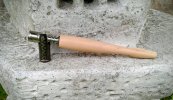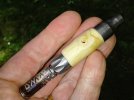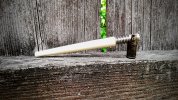-
SCAM WARNING! See how this scam works in Classifieds.
You are using an out of date browser. It may not display this or other websites correctly.
You should upgrade or use an alternative browser.
You should upgrade or use an alternative browser.
Making Draw Tubes... Flower Quince?
- Thread starter TommyDee
- Start date
-
- Tags
- flowering quince
TommyDee
Vaporitor
I am using an Emco Unimat 3 which I think qualifies as jewel's lathe. I torture myself to come up with these pieces.
Once I get a good core drilled through the stock, I can prep the blank for the lathe. I don't have a magic bullet for ensuring a centered core in smaller blanks. To make thing more challenging is that I prefer to core green blanks and let them cure. This makes sure the blanks don't crack from the inside out.
Then there is making the VC port. The blank must be stable to get this right. Any tip with loose o-rings can be the death of a good stem. I'm finally machining the VC port with the proper ID cutter. This means you also need a 3-jaw chuck or other means to spin the blank with support on only one end. This simply means the setup needs to be fairly sturdy.
And there are species - crap did I learn quickly that common wood blanks are not same! I am very happy turning Flowering Quince. It is a low-static species that I can turn with minimal dust control. Compare Rosewood which attached something in my insides and it sticks to everything! I have a feeling that static characteristics has a lot to do with bio-compatibility. I did some nice Cherry burls and those were much better on the static and only affected me mildly. I no longer have a pension for turning anything but FQ. It is the only thing I will trust unlined and feel good about turning in my home.
Most people prefer lined stems. That means you need the metal blanks to make the vape, along with a clever way to attach a mouthpiece. Now you are in the world of pen turning. You no longer have to deal with 'vape safe' protocols. Even stabilized woods become available for some awesome stems.
I only know how to make awesome one-piece FQ stems. I've grown to love this species and working FQ is unique to say the least. I only have experience with two shrubs outside my house that have been grow in heavy clay for better than 3 decades, if not 5. I'd like to think that mineral rich clay somehow adds to the fascinating self-healing properties of these shrubs. Wounds are filled with something that can only be describes as a super fine clay. If someone has a blank they wish for me to compare, let me know. I'd love to know of more sources. This stuff is rare enough even in my little setup.
Once I get a good core drilled through the stock, I can prep the blank for the lathe. I don't have a magic bullet for ensuring a centered core in smaller blanks. To make thing more challenging is that I prefer to core green blanks and let them cure. This makes sure the blanks don't crack from the inside out.
Then there is making the VC port. The blank must be stable to get this right. Any tip with loose o-rings can be the death of a good stem. I'm finally machining the VC port with the proper ID cutter. This means you also need a 3-jaw chuck or other means to spin the blank with support on only one end. This simply means the setup needs to be fairly sturdy.
And there are species - crap did I learn quickly that common wood blanks are not same! I am very happy turning Flowering Quince. It is a low-static species that I can turn with minimal dust control. Compare Rosewood which attached something in my insides and it sticks to everything! I have a feeling that static characteristics has a lot to do with bio-compatibility. I did some nice Cherry burls and those were much better on the static and only affected me mildly. I no longer have a pension for turning anything but FQ. It is the only thing I will trust unlined and feel good about turning in my home.
Most people prefer lined stems. That means you need the metal blanks to make the vape, along with a clever way to attach a mouthpiece. Now you are in the world of pen turning. You no longer have to deal with 'vape safe' protocols. Even stabilized woods become available for some awesome stems.
I only know how to make awesome one-piece FQ stems. I've grown to love this species and working FQ is unique to say the least. I only have experience with two shrubs outside my house that have been grow in heavy clay for better than 3 decades, if not 5. I'd like to think that mineral rich clay somehow adds to the fascinating self-healing properties of these shrubs. Wounds are filled with something that can only be describes as a super fine clay. If someone has a blank they wish for me to compare, let me know. I'd love to know of more sources. This stuff is rare enough even in my little setup.
stark1
Lonesome Planet
Planck
believes in Dog
If you have a real camera and some desire we can fix that. I'd be glad to help you.
If you are shooting with a phone avoid shooting in direct sunlight, tey cloudy days the north side of building and that sort of thing. Selecting backgrounds that are brighter than the fence can help as well. In auto exposure mode cameras are exposing for 18% grey for the entire image.
The eye is drawn to the brightest part of the image. The gap in the fence in your image is not good composition. Busy backgrounds in general should be avoided. With FQ it's really important because the detail is so subtle.
Faststone image editor is free and pretty powerful.
Dynamic range, overexposure and underexposure are constant issues in photography.
If you are shooting with a phone avoid shooting in direct sunlight, tey cloudy days the north side of building and that sort of thing. Selecting backgrounds that are brighter than the fence can help as well. In auto exposure mode cameras are exposing for 18% grey for the entire image.
The eye is drawn to the brightest part of the image. The gap in the fence in your image is not good composition. Busy backgrounds in general should be avoided. With FQ it's really important because the detail is so subtle.
Faststone image editor is free and pretty powerful.
Dynamic range, overexposure and underexposure are constant issues in photography.
TommyDee
Vaporitor
Of course my phone camera sucks @Planck but it is notably different than other pieces I've imaged. I can normally get some pretty detailed stuff with my aging Samsung phone camera but this definitely plays with the light. I do have a better camera I might have to charge up. If that doesn't do the trick, I'll PM you and get some edumication.
For what it's worth, that was taken in the shade of the house in afternoon Sun and no flash.
I also didn't have the heart to avoid that nice lush greenness. That is one of the native FQ bushes behind that fence.
@stark1 - the funnest part of making these is the final sanding. To ensure there are no lathe 'rings' in the wood, I finish the stem with 600 and 800 grit by hand in the direction of the grain. This stuff is a lot like working with marble - it feels creamy and soft although it is far from it. From there, one coat of shellac - fine steel wool to remove the raised grain - and two more shellackings with some high speed steel wool turning to make sure it is all smooth. This makes for a very durable finish as long as you don't get alcohol on it.
For what it's worth, that was taken in the shade of the house in afternoon Sun and no flash.
I also didn't have the heart to avoid that nice lush greenness. That is one of the native FQ bushes behind that fence.
@stark1 - the funnest part of making these is the final sanding. To ensure there are no lathe 'rings' in the wood, I finish the stem with 600 and 800 grit by hand in the direction of the grain. This stuff is a lot like working with marble - it feels creamy and soft although it is far from it. From there, one coat of shellac - fine steel wool to remove the raised grain - and two more shellackings with some high speed steel wool turning to make sure it is all smooth. This makes for a very durable finish as long as you don't get alcohol on it.
Last edited:
TheThriftDrifter
Land of the long vapor cloud
I've never heard shellackings worked so seamlessly into a sentence. 

Planck
believes in Dog
I finally got around to trying some finishing products for your gorgeous stems. I think we chatted about these earlier in the thread, I don't remember. The finishes are made in Germany by Osmo.

 osmocolorusa.com
osmocolorusa.com

The dry finish fulfils both the DIN EN 71.3 (suitable for children’s toys) and DIN 53160 (fast to perspiration and saliva) and as such is safe for humans, animals and plants. Osmo uses carefully harvested natural oils (sunflower, soya, linseed and thistle oils) and hard waxes (carnauba and candelilla waxes) for it’s finishes.
I've used the raw and matte high solids, wonderful products. Highly recommended.
The 4oz size would do hundreds of stems.
 www.leevalley.com
www.leevalley.com

Polyx® - Oil Raw - OSMO USA
Find a Dealer Near You APPLICATION TOOLS NEARLY INVISIBLE PROTECTION WITH NO COLOR CHANGE Osmo Polyx-Oil 3051 Raw is designed to retain an untreated appearance on light colored woods such as Oak, Ash, Birch and Maple. Neutralises

The dry finish fulfils both the DIN EN 71.3 (suitable for children’s toys) and DIN 53160 (fast to perspiration and saliva) and as such is safe for humans, animals and plants. Osmo uses carefully harvested natural oils (sunflower, soya, linseed and thistle oils) and hard waxes (carnauba and candelilla waxes) for it’s finishes.
I've used the raw and matte high solids, wonderful products. Highly recommended.
The 4oz size would do hundreds of stems.
Osmo Polyx Matte Hard Wax Oil - Lee Valley Tools
TommyDee
Vaporitor
Thank you @Planck . I've pretty much settled on the Shellac. This has been doing very well over the years. I still use the same stems I made years ago. Most are well seasoned with reclaim by now.
The only drawback to Shellac is that alcohol will remove it. How does Osmo behave after using an alcohol wipe? Is it considered a coating or an oil?
The only drawback to Shellac is that alcohol will remove it. How does Osmo behave after using an alcohol wipe? Is it considered a coating or an oil?
TheThriftDrifter
Land of the long vapor cloud
@TommyDee from their website......
Osmo Polyx is hard-wearing and has excellent resistance to water, alcohol and mild acids, making it suitable for a range of applications, from flooring and furniture to high-moisture environments such as kitchens or bathrooms. Non-toxic once cured, the finish is safe for food contact and complies with European standards for child safety (EN 71.3).
Two coats recommended; dries in 8 to 10 hours. A high-yield finish, it provides an impressive coverage of 190 square feet per 750ml (25.5 fl oz) can.
Osmo Polyx is hard-wearing and has excellent resistance to water, alcohol and mild acids, making it suitable for a range of applications, from flooring and furniture to high-moisture environments such as kitchens or bathrooms. Non-toxic once cured, the finish is safe for food contact and complies with European standards for child safety (EN 71.3).
Two coats recommended; dries in 8 to 10 hours. A high-yield finish, it provides an impressive coverage of 190 square feet per 750ml (25.5 fl oz) can.









